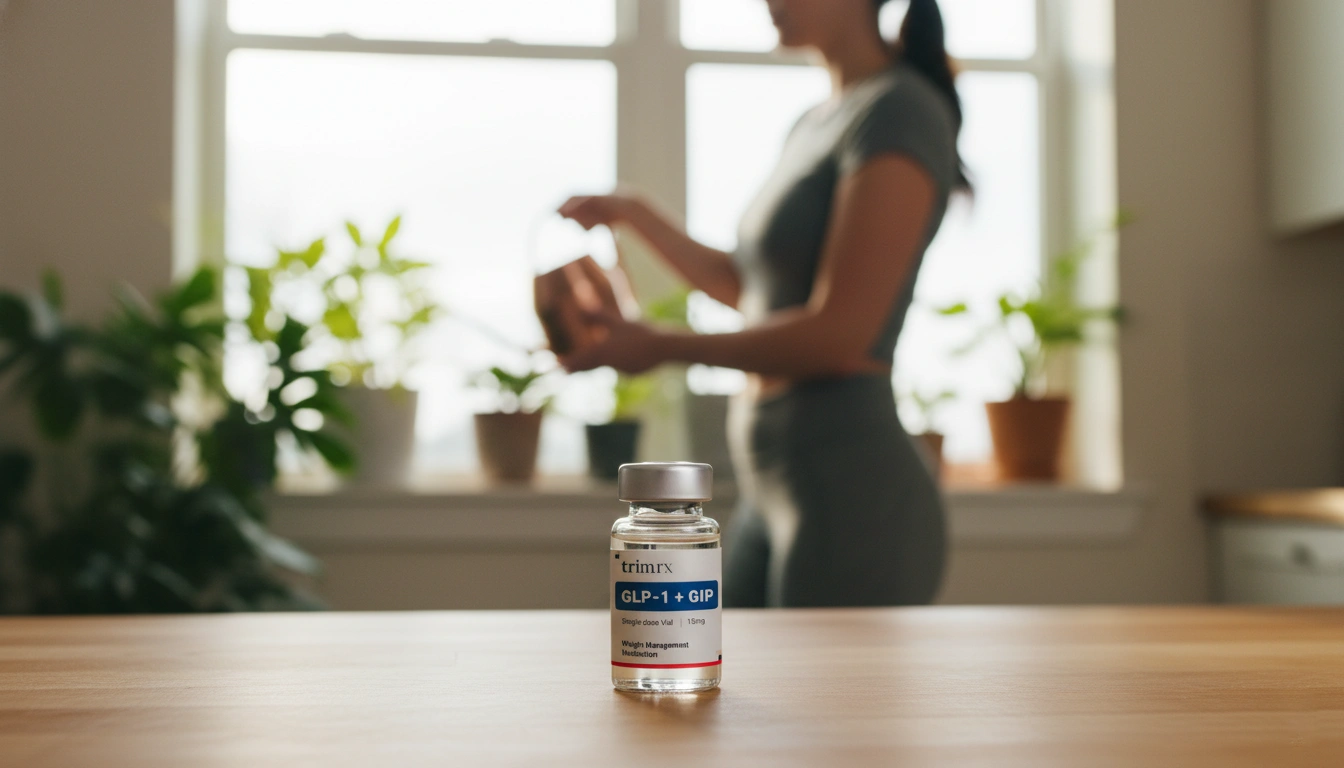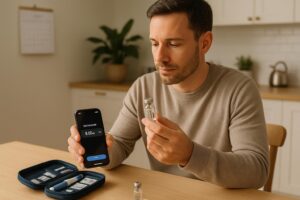How to Make Your Own GLP-1: A Comprehensive Guide to Boosting This Essential Hormone Naturally

Introduction
Did you know that your gut has the power to influence your appetite, blood sugar levels, and even your weight? One of the key players in this intricate system is a hormone called glucagon-like peptide-1 (GLP-1). This remarkable hormone is produced in the intestines and serves multiple vital functions, from stimulating insulin release to promoting satiety after meals. As we navigate through a world increasingly focused on health and wellness, understanding how to naturally enhance GLP-1 production can be a game-changer for those seeking to manage their weight effectively.
The significance of GLP-1 has gained traction in recent years, particularly with the rise of GLP-1 receptor agonist medications that mimic its effects for weight loss and diabetes management. However, while medications are effective, many are beginning to explore how dietary choices and lifestyle modifications can naturally boost GLP-1 levels. In this blog post, we will delve into the science behind GLP-1, explore the foods that can help increase its secretion, and discuss practical strategies for incorporating these elements into your everyday routine.
By the end of this article, you will have a clearer understanding of how to make your own GLP-1 through dietary adjustments and lifestyle changes. We aim to empower you with actionable insights that can lead to improved metabolic health and overall well-being. We will cover the following topics:
- Understanding GLP-1 and Its Functions
- The Role of Diet in GLP-1 Secretion
- Key Foods to Include for Boosting GLP-1
- Lifestyle Changes That Enhance GLP-1 Production
- The Connection Between Gut Health and GLP-1
- Practical Tips for Integrating GLP-1 Boosting Strategies
- Conclusion and Reflection
Let’s embark on this journey to understand and harness the power of GLP-1 together!
Understanding GLP-1 and Its Functions
GLP-1 is a hormone produced by the enteroendocrine cells in the intestines. It plays a crucial role in regulating glucose metabolism and appetite control. Here are some of its main functions:
- Stimulates Insulin Secretion: GLP-1 enhances the secretion of insulin from the pancreas in response to food intake, helping to lower blood sugar levels.
- Inhibits Glucagon Release: It reduces the release of glucagon, a hormone that raises blood sugar, thus maintaining balance in glucose levels.
- Slows Gastric Emptying: By slowing down how quickly food leaves the stomach, GLP-1 promotes prolonged feelings of fullness and satiety.
- Reduces Appetite: GLP-1 sends signals to the brain that suppress hunger, helping to manage food intake and support weight loss.
The importance of maintaining healthy GLP-1 levels cannot be overstated, especially for individuals managing conditions like obesity and type 2 diabetes. By increasing GLP-1 levels naturally, we can support our body’s efforts to regulate appetite and blood sugar effectively.
The Role of Diet in GLP-1 Secretion
Diet plays a pivotal role in the secretion of GLP-1. Specific nutrients and food types can stimulate the release of this hormone, contributing to better metabolic health. Foods rich in protein, healthy fats, and fiber have been shown to increase GLP-1 secretion, leading to enhanced feelings of fullness and improved blood sugar control.
Key Nutrients That Influence GLP-1
- Proteins: High-protein foods, such as lean meats, eggs, and dairy, can stimulate GLP-1 release. Studies have shown that protein intake significantly influences satiety and can lead to greater GLP-1 levels post-meal.
- Healthy Fats: Monounsaturated and polyunsaturated fats found in foods like avocados and nuts can also boost GLP-1 secretion. These fats not only provide essential nutrients but also help in regulating insulin sensitivity.
- Fiber: Soluble fiber, in particular, is known to enhance GLP-1 secretion. Foods high in fiber, such as whole grains, fruits, and vegetables, slow digestion and promote a gradual release of glucose into the bloodstream, which stimulates GLP-1 production.
Key Foods to Include for Boosting GLP-1
Incorporating specific foods into our diet can effectively enhance GLP-1 levels. Here are some of the top foods to consider:
1. Eggs
Eggs are an excellent source of protein and healthy fats. Research indicates that meals containing eggs can lead to lower post-meal blood glucose levels and increased feelings of fullness. Including eggs in your breakfast or meals can be a simple step toward boosting GLP-1.
2. Nuts
Certain nuts, such as almonds, walnuts, and pistachios, are rich in protein, fiber, and healthy fats. These nutrients can enhance GLP-1 secretion and contribute to better appetite control. A handful of nuts can serve as a nutritious snack that supports your weight management goals.
3. High Fiber Grains
Whole grains, such as oats, barley, and quinoa, are packed with soluble fiber that promotes GLP-1 release. A breakfast of oatmeal or a grain-based salad can be an effective way to start your day on a high note for GLP-1 production.
4. Avocados
Rich in monounsaturated fats and fiber, avocados not only provide satiety but also have been shown to increase GLP-1 levels. Adding avocado to salads or smoothies can enhance both flavor and nutritional value.
5. Vegetables
Many vegetables, particularly those high in fiber like Brussels sprouts, broccoli, and carrots, can positively impact GLP-1 levels. Incorporating a variety of colorful vegetables into your meals can aid in digestion and hormone regulation.
6. Healthy Fats
Using healthy fats like olive oil in cooking can also stimulate GLP-1 secretion. A Mediterranean diet rich in olive oil has been linked to improved metabolic health and higher post-meal GLP-1 levels.
7. Protein-Rich Foods
In addition to eggs, including lean meats, fish, and legumes in your diet can help increase GLP-1 levels. These protein sources contribute to a feeling of fullness and support overall health.
Lifestyle Changes That Enhance GLP-1 Production
Beyond dietary choices, certain lifestyle modifications can further enhance GLP-1 levels. Here are some effective strategies:
1. Regular Physical Activity
Engaging in regular exercise can positively influence GLP-1 secretion. Both aerobic and resistance training have been shown to enhance insulin function and increase GLP-1 levels. Aim for at least 150 minutes of moderate-intensity exercise each week.
2. Stay Hydrated
Proper hydration is essential for overall health and can support metabolic processes, including GLP-1 secretion. Drinking enough water throughout the day can help maintain optimal bodily functions.
3. Manage Stress
Chronic stress can negatively impact hormone levels, including GLP-1. Incorporating stress management techniques such as mindfulness, meditation, or yoga can help balance hormones and improve overall well-being.
4. Get Quality Sleep
Adequate sleep is crucial for hormone regulation, including GLP-1. Aim for 7-9 hours of quality sleep each night to support your body’s natural hormone production.
The Connection Between Gut Health and GLP-1
The health of our gut microbiome significantly impacts GLP-1 production. A balanced gut microbiome can enhance the secretion of GLP-1 through the fermentation of dietary fibers into short-chain fatty acids (SCFAs). Here are some key points regarding gut health and GLP-1:
- Diverse Microbiome: A diverse gut microbiome is associated with better metabolic health and increased GLP-1 production. Consuming a variety of fiber-rich foods can help nourish beneficial gut bacteria.
- Prebiotics and Probiotics: Including prebiotics (non-digestible fibers) and probiotics (live beneficial bacteria) in your diet can enhance gut health and subsequently boost GLP-1 levels. Foods like yogurt, kefir, garlic, and onions are excellent sources of prebiotics and probiotics.
- Gut Health Tests: Consider exploring your gut microbiome through testing to gain insights into its composition. This information can guide dietary and lifestyle changes to optimize GLP-1 production.
Practical Tips for Integrating GLP-1 Boosting Strategies
Now that we understand how to enhance GLP-1 levels through diet and lifestyle, here are some practical tips for integrating these strategies into your daily routine:
- Meal Planning: Plan your meals to include a variety of GLP-1-boosting foods. Focus on incorporating protein, healthy fats, and fiber-rich items into each meal.
- Healthy Snacking: Opt for snacks that are rich in protein and healthy fats, such as nuts, Greek yogurt, or hummus with vegetables. These choices can help maintain satiety between meals.
- Experiment with Recipes: Explore new recipes that incorporate GLP-1-enhancing ingredients. Try making grain bowls with quinoa, roasted veggies, and a protein source for a balanced meal.
- Stay Consistent: Consistency is key when it comes to dietary changes. Aim to make gradual adjustments to your eating habits and lifestyle to promote sustainable results.
- Monitor Your Progress: Keep track of how dietary and lifestyle changes affect your overall well-being. Pay attention to your energy levels, appetite, and mood to assess the impact of your efforts.
Conclusion and Reflection
In conclusion, understanding how to make your own GLP-1 naturally is an empowering journey toward better health. By focusing on nutrient-dense foods, maintaining a healthy lifestyle, and supporting gut health, we can enhance GLP-1 production and improve our metabolic health. We encourage you to take small, actionable steps towards incorporating these strategies into your daily routine.
As we reflect on the importance of GLP-1 in managing appetite and blood sugar levels, it’s clear that our choices matter. Together, let’s prioritize our health by embracing the foods and practices that support our bodies in producing this essential hormone.
Are you ready to take the next step in your health journey? Consider taking our free assessment quiz at TrimRx to explore personalized weight loss solutions that fit your needs. Let’s work together to achieve your wellness goals!
FAQ
What is GLP-1?
GLP-1, or glucagon-like peptide-1, is a hormone produced in the intestines that regulates blood sugar levels, appetite, and digestion.
How can I naturally boost GLP-1?
You can naturally boost GLP-1 by consuming foods rich in protein, healthy fats, and fiber, engaging in regular physical activity, maintaining gut health, and managing stress.
What foods increase GLP-1 levels?
Foods such as eggs, nuts, high-fiber grains, avocados, and vegetables are known to enhance GLP-1 secretion.
What lifestyle changes can help with GLP-1 production?
Regular exercise, staying hydrated, getting quality sleep, and managing stress can all support GLP-1 production.
How does gut health affect GLP-1?
A healthy and diverse gut microbiome can enhance GLP-1 secretion through the fermentation of dietary fibers into short-chain fatty acids.

Transforming Lives, One Step at a Time
Keep reading
7 Tips for Sticking to GLP-1 Injection Schedules
Seven practical strategies to keep weekly GLP‑1 injections on schedule—pick a routine day, set reminders, manage side effects, rotate sites, and avoid missed doses.
Custom GLP-1 Dosing for Kidney Disease
Personalized GLP-1 dosing for CKD patients with monitoring, dehydration and hypoglycemia risk mitigation, and guidance across all kidney disease stages.
Semaglutide vs Tirzepatide: Approved Uses
Two leading diabetes and weight-loss drugs differ in FDA-approved benefits — one adds heart, kidney and liver protection; the other treats obstructive sleep apnea.



